SnappyDrinks Plc: Business Finance Budgeting Report Analysis
VerifiedAdded on 2021/01/02
|15
|3740
|361
Report
AI Summary
This report delves into the core concepts of business finance budgeting, examining the purpose of budgeting, the processes involved in budget preparation, and its application in developing a business model for SnappyDrinks Plc. The report highlights traditional budgeting approaches, such as incremental budgeting, and analyzes their suitability for different parts of a business. It then explores alternative budgeting methods like rolling, zero-based, and activity-based budgeting, discussing their drawbacks and providing examples. The analysis includes a detailed cash flow statement to illustrate the application of budgeting techniques. The report concludes with an assessment of the appropriateness of various budgeting methods for SnappyDrinks Plc, providing valuable insights into cost management and financial planning.
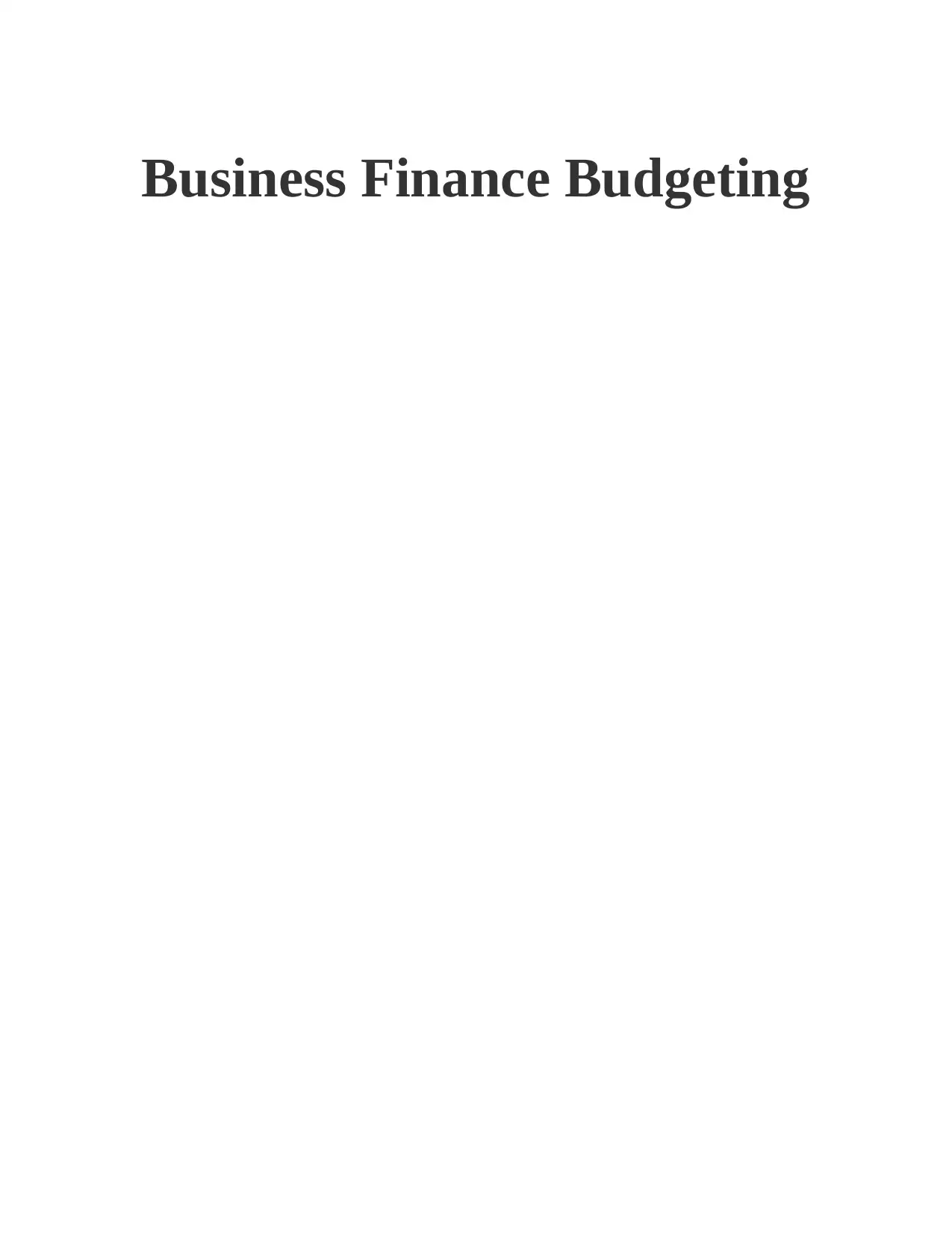
Business Finance Budgeting
Paraphrase This Document
Need a fresh take? Get an instant paraphrase of this document with our AI Paraphraser
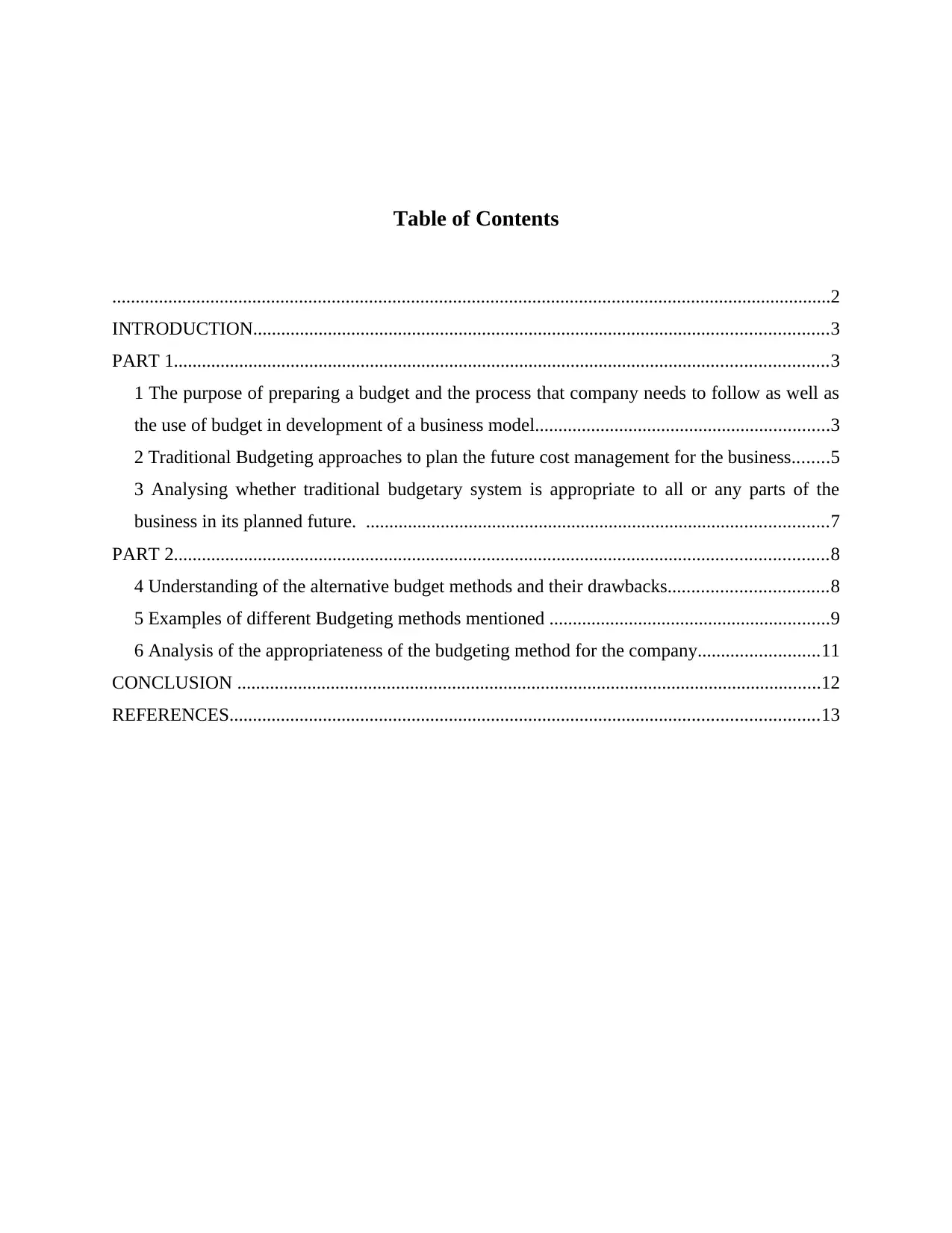
Table of Contents
..........................................................................................................................................................2
INTRODUCTION...........................................................................................................................3
PART 1............................................................................................................................................3
1 The purpose of preparing a budget and the process that company needs to follow as well as
the use of budget in development of a business model...............................................................3
2 Traditional Budgeting approaches to plan the future cost management for the business........5
3 Analysing whether traditional budgetary system is appropriate to all or any parts of the
business in its planned future. ...................................................................................................7
PART 2............................................................................................................................................8
4 Understanding of the alternative budget methods and their drawbacks..................................8
5 Examples of different Budgeting methods mentioned ............................................................9
6 Analysis of the appropriateness of the budgeting method for the company..........................11
CONCLUSION .............................................................................................................................12
REFERENCES..............................................................................................................................13
..........................................................................................................................................................2
INTRODUCTION...........................................................................................................................3
PART 1............................................................................................................................................3
1 The purpose of preparing a budget and the process that company needs to follow as well as
the use of budget in development of a business model...............................................................3
2 Traditional Budgeting approaches to plan the future cost management for the business........5
3 Analysing whether traditional budgetary system is appropriate to all or any parts of the
business in its planned future. ...................................................................................................7
PART 2............................................................................................................................................8
4 Understanding of the alternative budget methods and their drawbacks..................................8
5 Examples of different Budgeting methods mentioned ............................................................9
6 Analysis of the appropriateness of the budgeting method for the company..........................11
CONCLUSION .............................................................................................................................12
REFERENCES..............................................................................................................................13
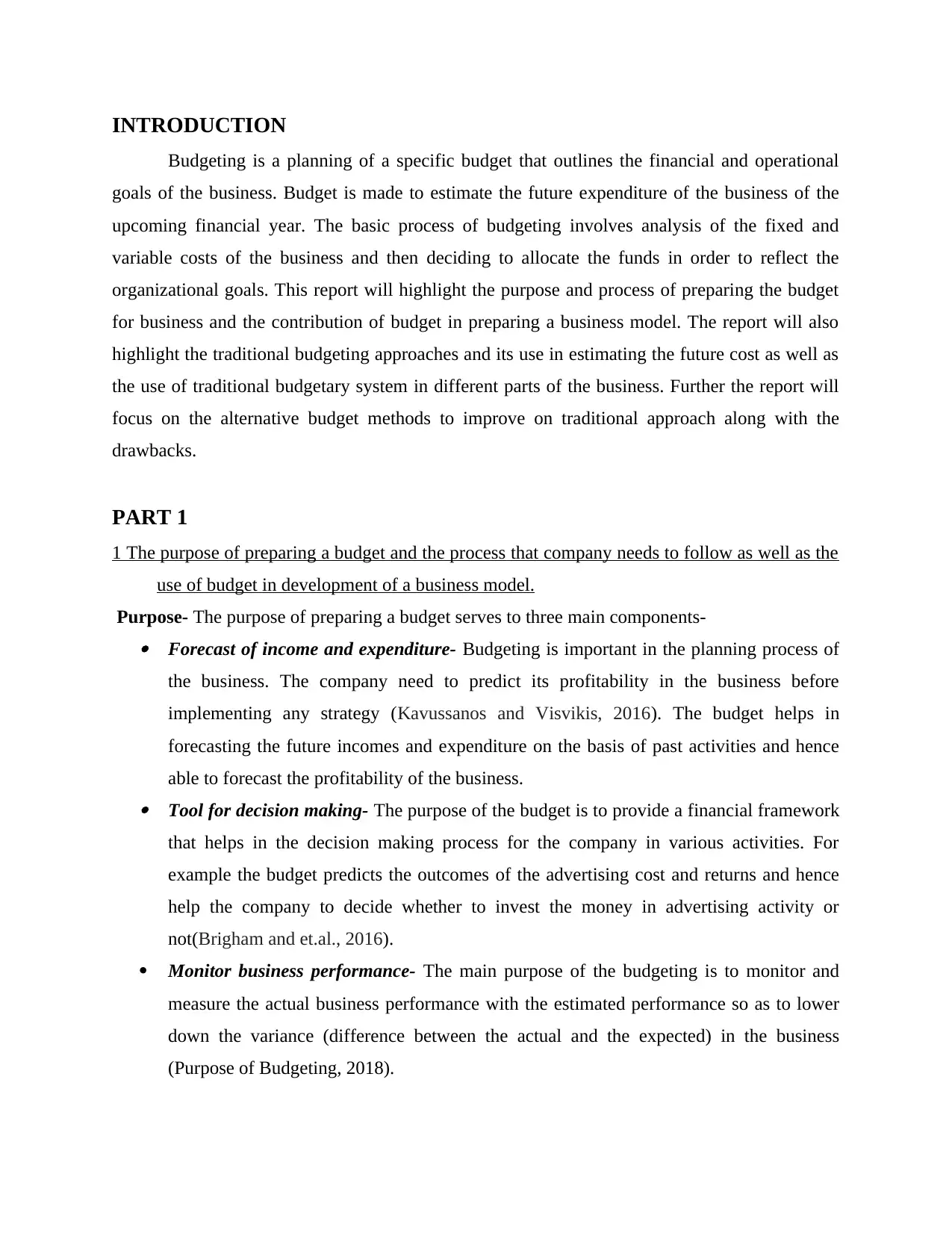
INTRODUCTION
Budgeting is a planning of a specific budget that outlines the financial and operational
goals of the business. Budget is made to estimate the future expenditure of the business of the
upcoming financial year. The basic process of budgeting involves analysis of the fixed and
variable costs of the business and then deciding to allocate the funds in order to reflect the
organizational goals. This report will highlight the purpose and process of preparing the budget
for business and the contribution of budget in preparing a business model. The report will also
highlight the traditional budgeting approaches and its use in estimating the future cost as well as
the use of traditional budgetary system in different parts of the business. Further the report will
focus on the alternative budget methods to improve on traditional approach along with the
drawbacks.
PART 1
1 The purpose of preparing a budget and the process that company needs to follow as well as the
use of budget in development of a business model.
Purpose- The purpose of preparing a budget serves to three main components- Forecast of income and expenditure- Budgeting is important in the planning process of
the business. The company need to predict its profitability in the business before
implementing any strategy (Kavussanos and Visvikis, 2016). The budget helps in
forecasting the future incomes and expenditure on the basis of past activities and hence
able to forecast the profitability of the business. Tool for decision making- The purpose of the budget is to provide a financial framework
that helps in the decision making process for the company in various activities. For
example the budget predicts the outcomes of the advertising cost and returns and hence
help the company to decide whether to invest the money in advertising activity or
not(Brigham and et.al., 2016).
Monitor business performance- The main purpose of the budgeting is to monitor and
measure the actual business performance with the estimated performance so as to lower
down the variance (difference between the actual and the expected) in the business
(Purpose of Budgeting, 2018).
Budgeting is a planning of a specific budget that outlines the financial and operational
goals of the business. Budget is made to estimate the future expenditure of the business of the
upcoming financial year. The basic process of budgeting involves analysis of the fixed and
variable costs of the business and then deciding to allocate the funds in order to reflect the
organizational goals. This report will highlight the purpose and process of preparing the budget
for business and the contribution of budget in preparing a business model. The report will also
highlight the traditional budgeting approaches and its use in estimating the future cost as well as
the use of traditional budgetary system in different parts of the business. Further the report will
focus on the alternative budget methods to improve on traditional approach along with the
drawbacks.
PART 1
1 The purpose of preparing a budget and the process that company needs to follow as well as the
use of budget in development of a business model.
Purpose- The purpose of preparing a budget serves to three main components- Forecast of income and expenditure- Budgeting is important in the planning process of
the business. The company need to predict its profitability in the business before
implementing any strategy (Kavussanos and Visvikis, 2016). The budget helps in
forecasting the future incomes and expenditure on the basis of past activities and hence
able to forecast the profitability of the business. Tool for decision making- The purpose of the budget is to provide a financial framework
that helps in the decision making process for the company in various activities. For
example the budget predicts the outcomes of the advertising cost and returns and hence
help the company to decide whether to invest the money in advertising activity or
not(Brigham and et.al., 2016).
Monitor business performance- The main purpose of the budgeting is to monitor and
measure the actual business performance with the estimated performance so as to lower
down the variance (difference between the actual and the expected) in the business
(Purpose of Budgeting, 2018).
⊘ This is a preview!⊘
Do you want full access?
Subscribe today to unlock all pages.

Trusted by 1+ million students worldwide
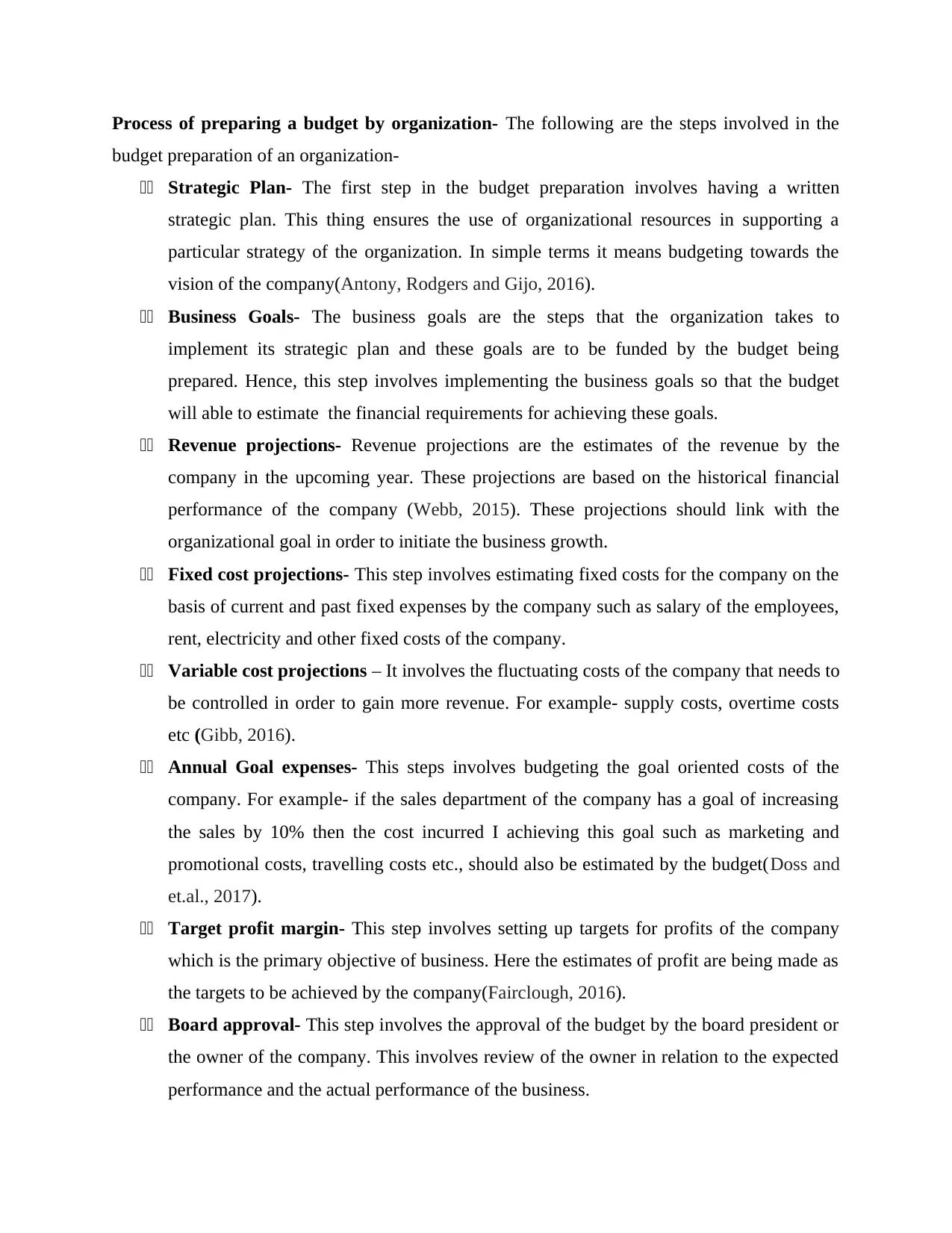
Process of preparing a budget by organization- The following are the steps involved in the
budget preparation of an organization-
11 Strategic Plan- The first step in the budget preparation involves having a written
strategic plan. This thing ensures the use of organizational resources in supporting a
particular strategy of the organization. In simple terms it means budgeting towards the
vision of the company(Antony, Rodgers and Gijo, 2016).
11 Business Goals- The business goals are the steps that the organization takes to
implement its strategic plan and these goals are to be funded by the budget being
prepared. Hence, this step involves implementing the business goals so that the budget
will able to estimate the financial requirements for achieving these goals.
11 Revenue projections- Revenue projections are the estimates of the revenue by the
company in the upcoming year. These projections are based on the historical financial
performance of the company (Webb, 2015). These projections should link with the
organizational goal in order to initiate the business growth.
11 Fixed cost projections- This step involves estimating fixed costs for the company on the
basis of current and past fixed expenses by the company such as salary of the employees,
rent, electricity and other fixed costs of the company.
11 Variable cost projections – It involves the fluctuating costs of the company that needs to
be controlled in order to gain more revenue. For example- supply costs, overtime costs
etc (Gibb, 2016).
11 Annual Goal expenses- This steps involves budgeting the goal oriented costs of the
company. For example- if the sales department of the company has a goal of increasing
the sales by 10% then the cost incurred I achieving this goal such as marketing and
promotional costs, travelling costs etc., should also be estimated by the budget(Doss and
et.al., 2017).
11 Target profit margin- This step involves setting up targets for profits of the company
which is the primary objective of business. Here the estimates of profit are being made as
the targets to be achieved by the company(Fairclough, 2016).
11 Board approval- This step involves the approval of the budget by the board president or
the owner of the company. This involves review of the owner in relation to the expected
performance and the actual performance of the business.
budget preparation of an organization-
11 Strategic Plan- The first step in the budget preparation involves having a written
strategic plan. This thing ensures the use of organizational resources in supporting a
particular strategy of the organization. In simple terms it means budgeting towards the
vision of the company(Antony, Rodgers and Gijo, 2016).
11 Business Goals- The business goals are the steps that the organization takes to
implement its strategic plan and these goals are to be funded by the budget being
prepared. Hence, this step involves implementing the business goals so that the budget
will able to estimate the financial requirements for achieving these goals.
11 Revenue projections- Revenue projections are the estimates of the revenue by the
company in the upcoming year. These projections are based on the historical financial
performance of the company (Webb, 2015). These projections should link with the
organizational goal in order to initiate the business growth.
11 Fixed cost projections- This step involves estimating fixed costs for the company on the
basis of current and past fixed expenses by the company such as salary of the employees,
rent, electricity and other fixed costs of the company.
11 Variable cost projections – It involves the fluctuating costs of the company that needs to
be controlled in order to gain more revenue. For example- supply costs, overtime costs
etc (Gibb, 2016).
11 Annual Goal expenses- This steps involves budgeting the goal oriented costs of the
company. For example- if the sales department of the company has a goal of increasing
the sales by 10% then the cost incurred I achieving this goal such as marketing and
promotional costs, travelling costs etc., should also be estimated by the budget(Doss and
et.al., 2017).
11 Target profit margin- This step involves setting up targets for profits of the company
which is the primary objective of business. Here the estimates of profit are being made as
the targets to be achieved by the company(Fairclough, 2016).
11 Board approval- This step involves the approval of the budget by the board president or
the owner of the company. This involves review of the owner in relation to the expected
performance and the actual performance of the business.
Paraphrase This Document
Need a fresh take? Get an instant paraphrase of this document with our AI Paraphraser
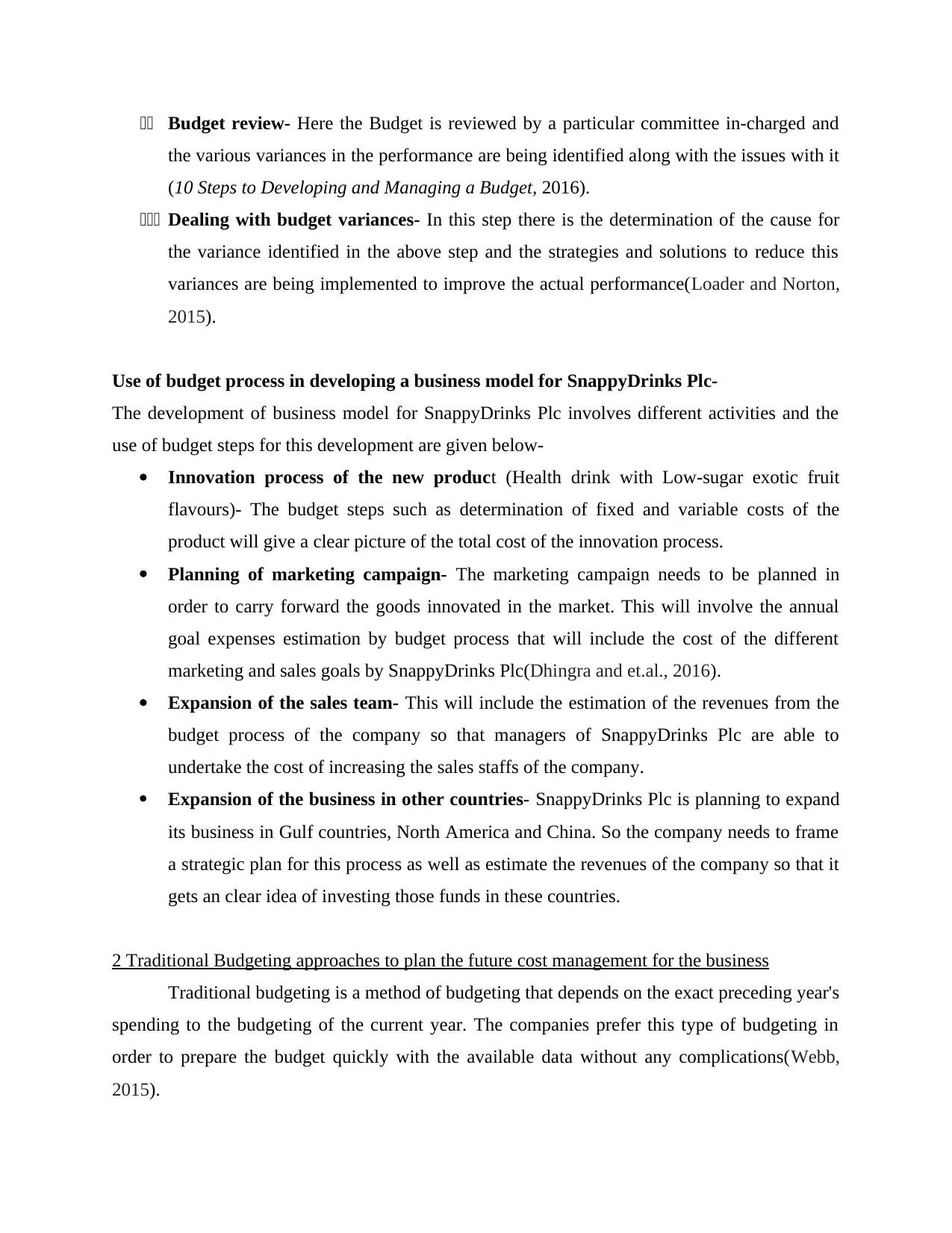
11 Budget review- Here the Budget is reviewed by a particular committee in-charged and
the various variances in the performance are being identified along with the issues with it
(10 Steps to Developing and Managing a Budget, 2016).
111 Dealing with budget variances- In this step there is the determination of the cause for
the variance identified in the above step and the strategies and solutions to reduce this
variances are being implemented to improve the actual performance(Loader and Norton,
2015).
Use of budget process in developing a business model for SnappyDrinks Plc-
The development of business model for SnappyDrinks Plc involves different activities and the
use of budget steps for this development are given below-
Innovation process of the new product (Health drink with Low-sugar exotic fruit
flavours)- The budget steps such as determination of fixed and variable costs of the
product will give a clear picture of the total cost of the innovation process.
Planning of marketing campaign- The marketing campaign needs to be planned in
order to carry forward the goods innovated in the market. This will involve the annual
goal expenses estimation by budget process that will include the cost of the different
marketing and sales goals by SnappyDrinks Plc(Dhingra and et.al., 2016).
Expansion of the sales team- This will include the estimation of the revenues from the
budget process of the company so that managers of SnappyDrinks Plc are able to
undertake the cost of increasing the sales staffs of the company.
Expansion of the business in other countries- SnappyDrinks Plc is planning to expand
its business in Gulf countries, North America and China. So the company needs to frame
a strategic plan for this process as well as estimate the revenues of the company so that it
gets an clear idea of investing those funds in these countries.
2 Traditional Budgeting approaches to plan the future cost management for the business
Traditional budgeting is a method of budgeting that depends on the exact preceding year's
spending to the budgeting of the current year. The companies prefer this type of budgeting in
order to prepare the budget quickly with the available data without any complications(Webb,
2015).
the various variances in the performance are being identified along with the issues with it
(10 Steps to Developing and Managing a Budget, 2016).
111 Dealing with budget variances- In this step there is the determination of the cause for
the variance identified in the above step and the strategies and solutions to reduce this
variances are being implemented to improve the actual performance(Loader and Norton,
2015).
Use of budget process in developing a business model for SnappyDrinks Plc-
The development of business model for SnappyDrinks Plc involves different activities and the
use of budget steps for this development are given below-
Innovation process of the new product (Health drink with Low-sugar exotic fruit
flavours)- The budget steps such as determination of fixed and variable costs of the
product will give a clear picture of the total cost of the innovation process.
Planning of marketing campaign- The marketing campaign needs to be planned in
order to carry forward the goods innovated in the market. This will involve the annual
goal expenses estimation by budget process that will include the cost of the different
marketing and sales goals by SnappyDrinks Plc(Dhingra and et.al., 2016).
Expansion of the sales team- This will include the estimation of the revenues from the
budget process of the company so that managers of SnappyDrinks Plc are able to
undertake the cost of increasing the sales staffs of the company.
Expansion of the business in other countries- SnappyDrinks Plc is planning to expand
its business in Gulf countries, North America and China. So the company needs to frame
a strategic plan for this process as well as estimate the revenues of the company so that it
gets an clear idea of investing those funds in these countries.
2 Traditional Budgeting approaches to plan the future cost management for the business
Traditional budgeting is a method of budgeting that depends on the exact preceding year's
spending to the budgeting of the current year. The companies prefer this type of budgeting in
order to prepare the budget quickly with the available data without any complications(Webb,
2015).
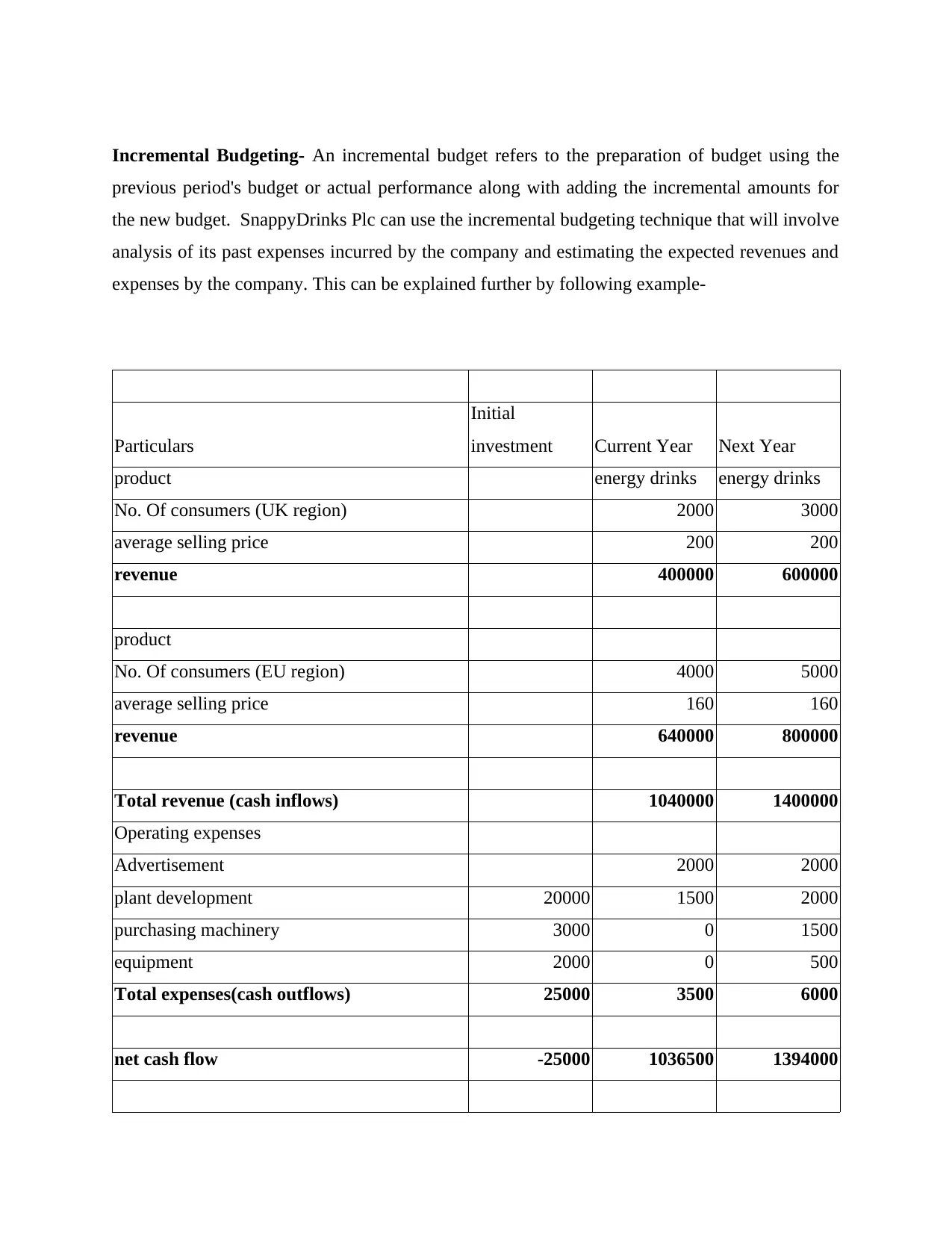
Incremental Budgeting- An incremental budget refers to the preparation of budget using the
previous period's budget or actual performance along with adding the incremental amounts for
the new budget. SnappyDrinks Plc can use the incremental budgeting technique that will involve
analysis of its past expenses incurred by the company and estimating the expected revenues and
expenses by the company. This can be explained further by following example-
Particulars
Initial
investment Current Year Next Year
product energy drinks energy drinks
No. Of consumers (UK region) 2000 3000
average selling price 200 200
revenue 400000 600000
product
No. Of consumers (EU region) 4000 5000
average selling price 160 160
revenue 640000 800000
Total revenue (cash inflows) 1040000 1400000
Operating expenses
Advertisement 2000 2000
plant development 20000 1500 2000
purchasing machinery 3000 0 1500
equipment 2000 0 500
Total expenses(cash outflows) 25000 3500 6000
net cash flow -25000 1036500 1394000
previous period's budget or actual performance along with adding the incremental amounts for
the new budget. SnappyDrinks Plc can use the incremental budgeting technique that will involve
analysis of its past expenses incurred by the company and estimating the expected revenues and
expenses by the company. This can be explained further by following example-
Particulars
Initial
investment Current Year Next Year
product energy drinks energy drinks
No. Of consumers (UK region) 2000 3000
average selling price 200 200
revenue 400000 600000
product
No. Of consumers (EU region) 4000 5000
average selling price 160 160
revenue 640000 800000
Total revenue (cash inflows) 1040000 1400000
Operating expenses
Advertisement 2000 2000
plant development 20000 1500 2000
purchasing machinery 3000 0 1500
equipment 2000 0 500
Total expenses(cash outflows) 25000 3500 6000
net cash flow -25000 1036500 1394000
⊘ This is a preview!⊘
Do you want full access?
Subscribe today to unlock all pages.

Trusted by 1+ million students worldwide
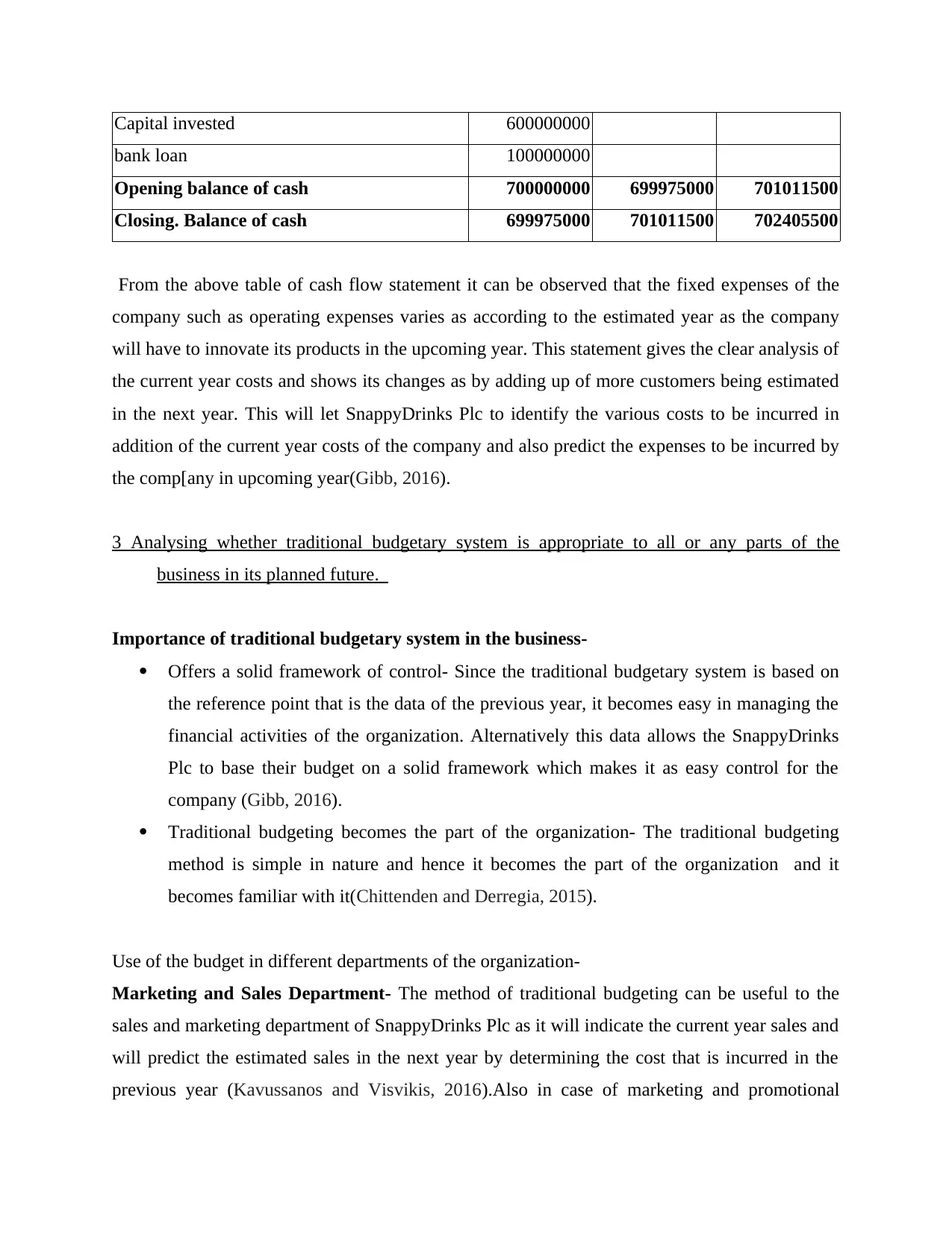
Capital invested 600000000
bank loan 100000000
Opening balance of cash 700000000 699975000 701011500
Closing. Balance of cash 699975000 701011500 702405500
From the above table of cash flow statement it can be observed that the fixed expenses of the
company such as operating expenses varies as according to the estimated year as the company
will have to innovate its products in the upcoming year. This statement gives the clear analysis of
the current year costs and shows its changes as by adding up of more customers being estimated
in the next year. This will let SnappyDrinks Plc to identify the various costs to be incurred in
addition of the current year costs of the company and also predict the expenses to be incurred by
the comp[any in upcoming year(Gibb, 2016).
3 Analysing whether traditional budgetary system is appropriate to all or any parts of the
business in its planned future.
Importance of traditional budgetary system in the business-
Offers a solid framework of control- Since the traditional budgetary system is based on
the reference point that is the data of the previous year, it becomes easy in managing the
financial activities of the organization. Alternatively this data allows the SnappyDrinks
Plc to base their budget on a solid framework which makes it as easy control for the
company (Gibb, 2016).
Traditional budgeting becomes the part of the organization- The traditional budgeting
method is simple in nature and hence it becomes the part of the organization and it
becomes familiar with it(Chittenden and Derregia, 2015).
Use of the budget in different departments of the organization-
Marketing and Sales Department- The method of traditional budgeting can be useful to the
sales and marketing department of SnappyDrinks Plc as it will indicate the current year sales and
will predict the estimated sales in the next year by determining the cost that is incurred in the
previous year (Kavussanos and Visvikis, 2016).Also in case of marketing and promotional
bank loan 100000000
Opening balance of cash 700000000 699975000 701011500
Closing. Balance of cash 699975000 701011500 702405500
From the above table of cash flow statement it can be observed that the fixed expenses of the
company such as operating expenses varies as according to the estimated year as the company
will have to innovate its products in the upcoming year. This statement gives the clear analysis of
the current year costs and shows its changes as by adding up of more customers being estimated
in the next year. This will let SnappyDrinks Plc to identify the various costs to be incurred in
addition of the current year costs of the company and also predict the expenses to be incurred by
the comp[any in upcoming year(Gibb, 2016).
3 Analysing whether traditional budgetary system is appropriate to all or any parts of the
business in its planned future.
Importance of traditional budgetary system in the business-
Offers a solid framework of control- Since the traditional budgetary system is based on
the reference point that is the data of the previous year, it becomes easy in managing the
financial activities of the organization. Alternatively this data allows the SnappyDrinks
Plc to base their budget on a solid framework which makes it as easy control for the
company (Gibb, 2016).
Traditional budgeting becomes the part of the organization- The traditional budgeting
method is simple in nature and hence it becomes the part of the organization and it
becomes familiar with it(Chittenden and Derregia, 2015).
Use of the budget in different departments of the organization-
Marketing and Sales Department- The method of traditional budgeting can be useful to the
sales and marketing department of SnappyDrinks Plc as it will indicate the current year sales and
will predict the estimated sales in the next year by determining the cost that is incurred in the
previous year (Kavussanos and Visvikis, 2016).Also in case of marketing and promotional
Paraphrase This Document
Need a fresh take? Get an instant paraphrase of this document with our AI Paraphraser
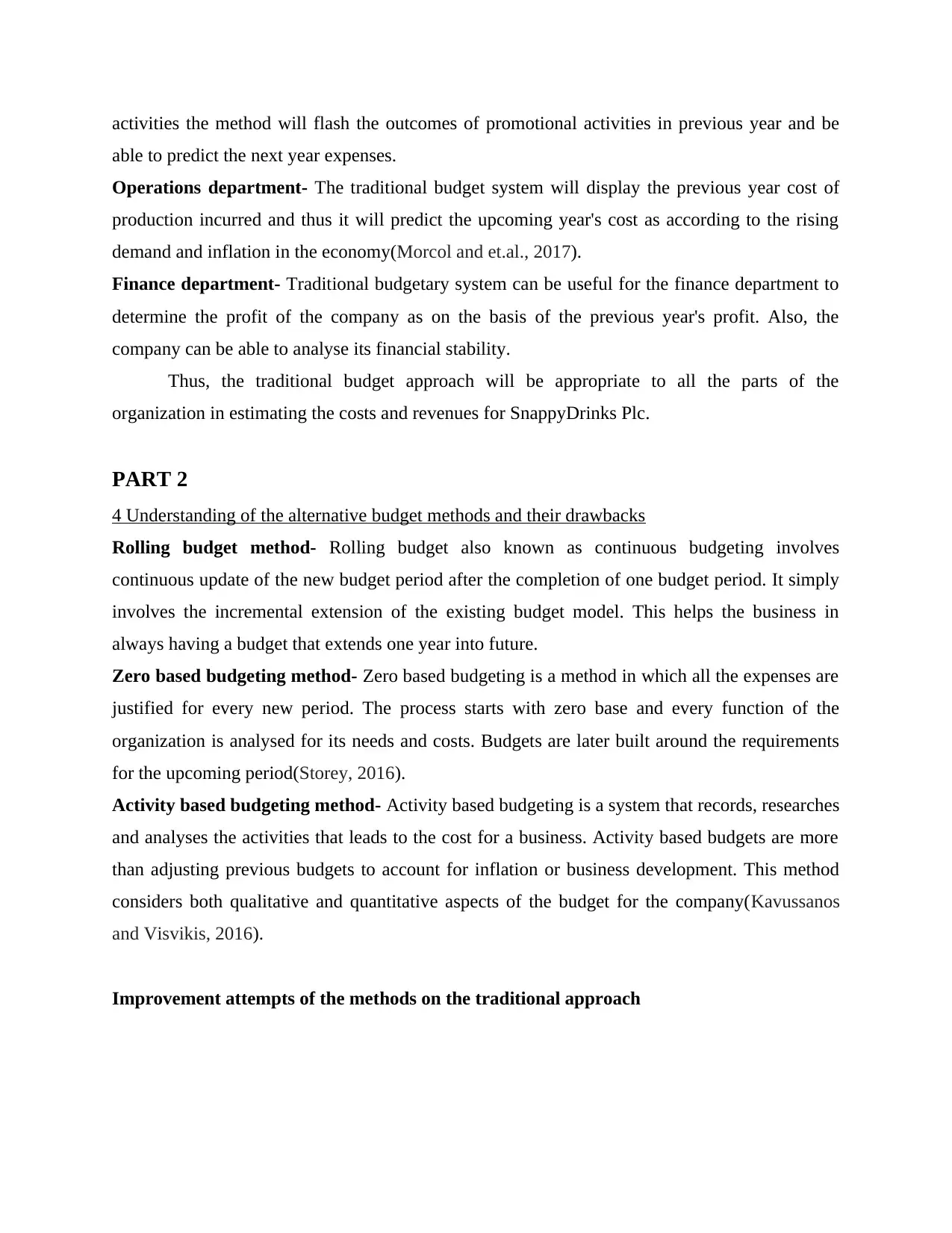
activities the method will flash the outcomes of promotional activities in previous year and be
able to predict the next year expenses.
Operations department- The traditional budget system will display the previous year cost of
production incurred and thus it will predict the upcoming year's cost as according to the rising
demand and inflation in the economy(Morcol and et.al., 2017).
Finance department- Traditional budgetary system can be useful for the finance department to
determine the profit of the company as on the basis of the previous year's profit. Also, the
company can be able to analyse its financial stability.
Thus, the traditional budget approach will be appropriate to all the parts of the
organization in estimating the costs and revenues for SnappyDrinks Plc.
PART 2
4 Understanding of the alternative budget methods and their drawbacks
Rolling budget method- Rolling budget also known as continuous budgeting involves
continuous update of the new budget period after the completion of one budget period. It simply
involves the incremental extension of the existing budget model. This helps the business in
always having a budget that extends one year into future.
Zero based budgeting method- Zero based budgeting is a method in which all the expenses are
justified for every new period. The process starts with zero base and every function of the
organization is analysed for its needs and costs. Budgets are later built around the requirements
for the upcoming period(Storey, 2016).
Activity based budgeting method- Activity based budgeting is a system that records, researches
and analyses the activities that leads to the cost for a business. Activity based budgets are more
than adjusting previous budgets to account for inflation or business development. This method
considers both qualitative and quantitative aspects of the budget for the company(Kavussanos
and Visvikis, 2016).
Improvement attempts of the methods on the traditional approach
able to predict the next year expenses.
Operations department- The traditional budget system will display the previous year cost of
production incurred and thus it will predict the upcoming year's cost as according to the rising
demand and inflation in the economy(Morcol and et.al., 2017).
Finance department- Traditional budgetary system can be useful for the finance department to
determine the profit of the company as on the basis of the previous year's profit. Also, the
company can be able to analyse its financial stability.
Thus, the traditional budget approach will be appropriate to all the parts of the
organization in estimating the costs and revenues for SnappyDrinks Plc.
PART 2
4 Understanding of the alternative budget methods and their drawbacks
Rolling budget method- Rolling budget also known as continuous budgeting involves
continuous update of the new budget period after the completion of one budget period. It simply
involves the incremental extension of the existing budget model. This helps the business in
always having a budget that extends one year into future.
Zero based budgeting method- Zero based budgeting is a method in which all the expenses are
justified for every new period. The process starts with zero base and every function of the
organization is analysed for its needs and costs. Budgets are later built around the requirements
for the upcoming period(Storey, 2016).
Activity based budgeting method- Activity based budgeting is a system that records, researches
and analyses the activities that leads to the cost for a business. Activity based budgets are more
than adjusting previous budgets to account for inflation or business development. This method
considers both qualitative and quantitative aspects of the budget for the company(Kavussanos
and Visvikis, 2016).
Improvement attempts of the methods on the traditional approach
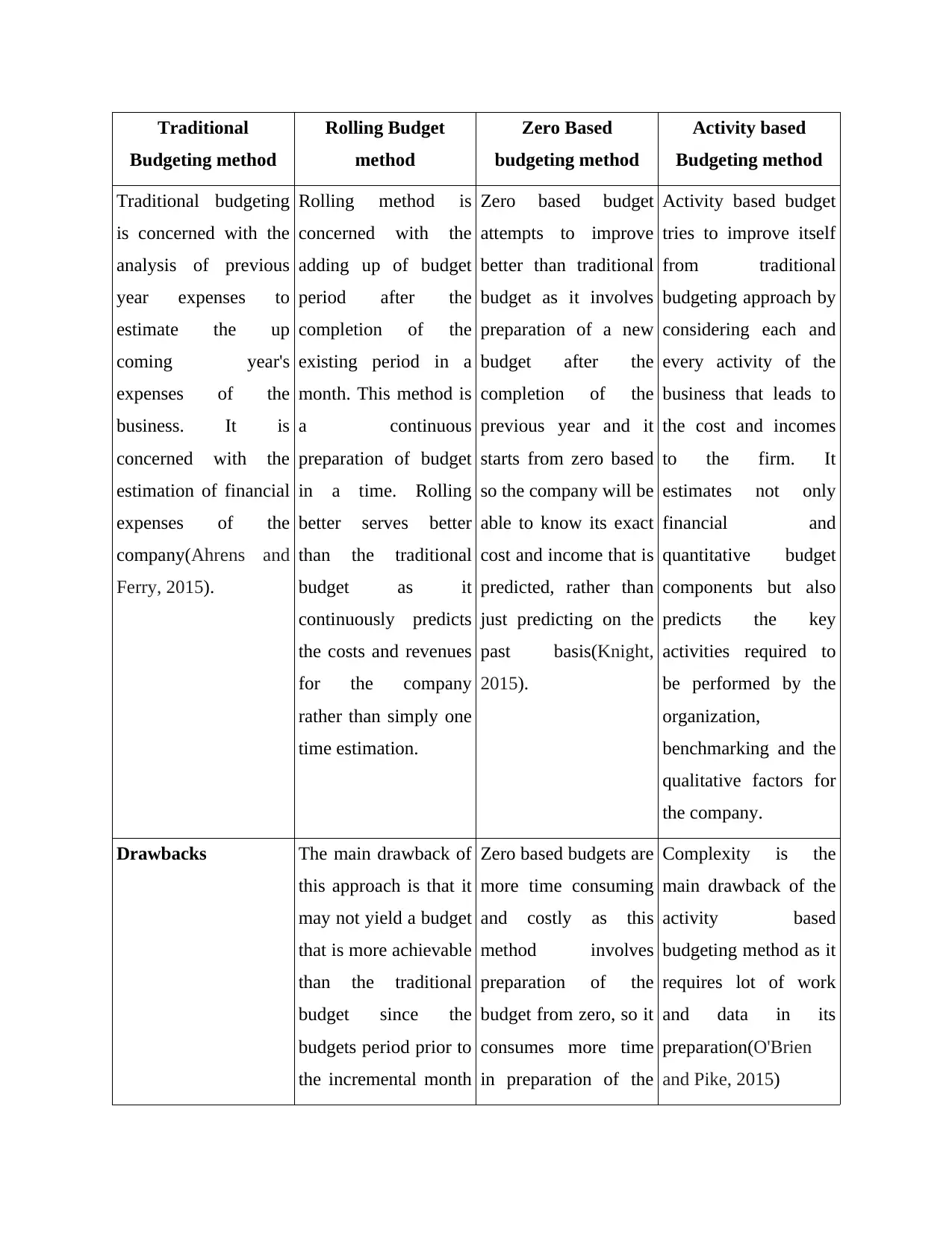
Traditional
Budgeting method
Rolling Budget
method
Zero Based
budgeting method
Activity based
Budgeting method
Traditional budgeting
is concerned with the
analysis of previous
year expenses to
estimate the up
coming year's
expenses of the
business. It is
concerned with the
estimation of financial
expenses of the
company(Ahrens and
Ferry, 2015).
Rolling method is
concerned with the
adding up of budget
period after the
completion of the
existing period in a
month. This method is
a continuous
preparation of budget
in a time. Rolling
better serves better
than the traditional
budget as it
continuously predicts
the costs and revenues
for the company
rather than simply one
time estimation.
Zero based budget
attempts to improve
better than traditional
budget as it involves
preparation of a new
budget after the
completion of the
previous year and it
starts from zero based
so the company will be
able to know its exact
cost and income that is
predicted, rather than
just predicting on the
past basis(Knight,
2015).
Activity based budget
tries to improve itself
from traditional
budgeting approach by
considering each and
every activity of the
business that leads to
the cost and incomes
to the firm. It
estimates not only
financial and
quantitative budget
components but also
predicts the key
activities required to
be performed by the
organization,
benchmarking and the
qualitative factors for
the company.
Drawbacks The main drawback of
this approach is that it
may not yield a budget
that is more achievable
than the traditional
budget since the
budgets period prior to
the incremental month
Zero based budgets are
more time consuming
and costly as this
method involves
preparation of the
budget from zero, so it
consumes more time
in preparation of the
Complexity is the
main drawback of the
activity based
budgeting method as it
requires lot of work
and data in its
preparation(O'Brien
and Pike, 2015)
Budgeting method
Rolling Budget
method
Zero Based
budgeting method
Activity based
Budgeting method
Traditional budgeting
is concerned with the
analysis of previous
year expenses to
estimate the up
coming year's
expenses of the
business. It is
concerned with the
estimation of financial
expenses of the
company(Ahrens and
Ferry, 2015).
Rolling method is
concerned with the
adding up of budget
period after the
completion of the
existing period in a
month. This method is
a continuous
preparation of budget
in a time. Rolling
better serves better
than the traditional
budget as it
continuously predicts
the costs and revenues
for the company
rather than simply one
time estimation.
Zero based budget
attempts to improve
better than traditional
budget as it involves
preparation of a new
budget after the
completion of the
previous year and it
starts from zero based
so the company will be
able to know its exact
cost and income that is
predicted, rather than
just predicting on the
past basis(Knight,
2015).
Activity based budget
tries to improve itself
from traditional
budgeting approach by
considering each and
every activity of the
business that leads to
the cost and incomes
to the firm. It
estimates not only
financial and
quantitative budget
components but also
predicts the key
activities required to
be performed by the
organization,
benchmarking and the
qualitative factors for
the company.
Drawbacks The main drawback of
this approach is that it
may not yield a budget
that is more achievable
than the traditional
budget since the
budgets period prior to
the incremental month
Zero based budgets are
more time consuming
and costly as this
method involves
preparation of the
budget from zero, so it
consumes more time
in preparation of the
Complexity is the
main drawback of the
activity based
budgeting method as it
requires lot of work
and data in its
preparation(O'Brien
and Pike, 2015)
⊘ This is a preview!⊘
Do you want full access?
Subscribe today to unlock all pages.

Trusted by 1+ million students worldwide
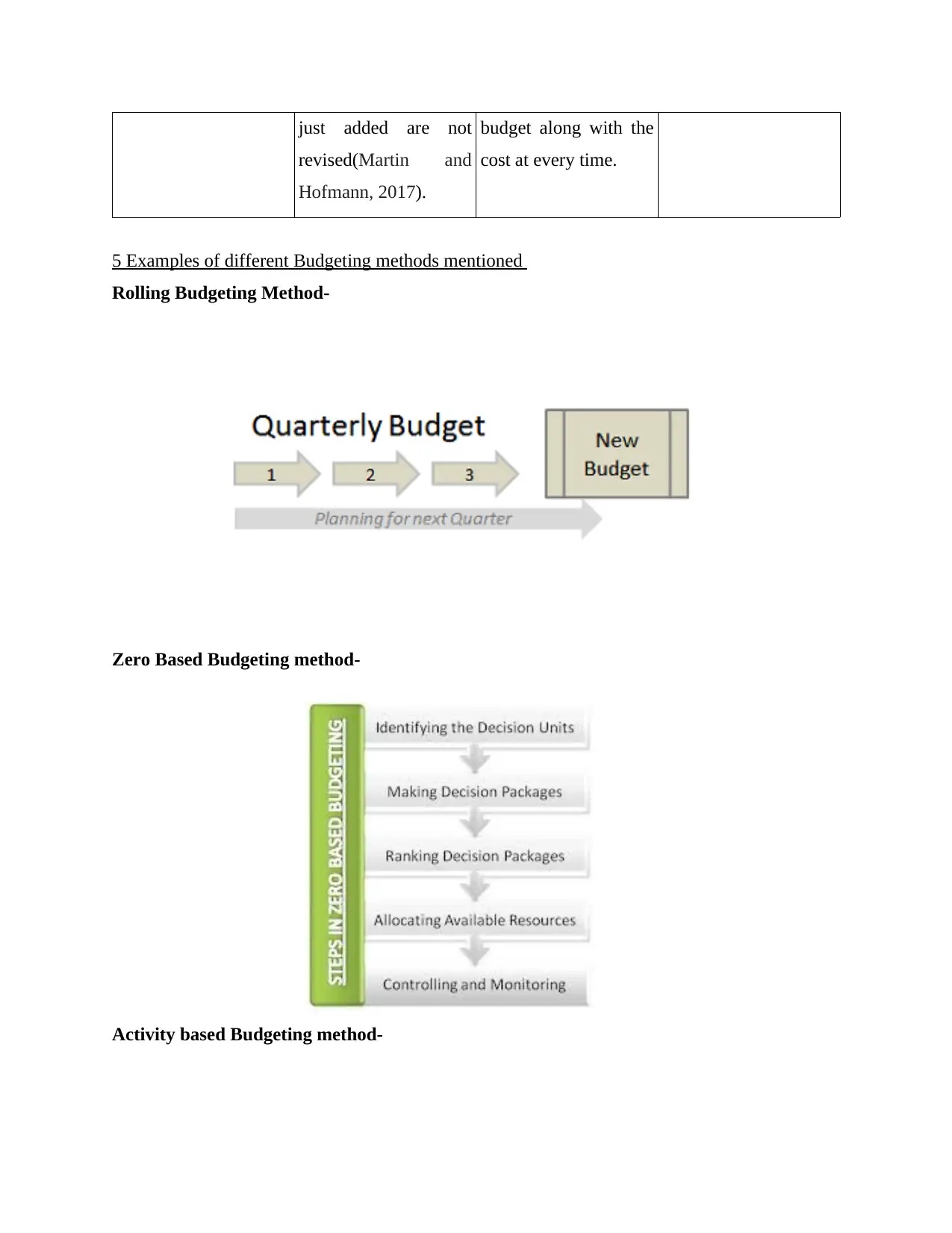
just added are not
revised(Martin and
Hofmann, 2017).
budget along with the
cost at every time.
5 Examples of different Budgeting methods mentioned
Rolling Budgeting Method-
Zero Based Budgeting method-
Activity based Budgeting method-
revised(Martin and
Hofmann, 2017).
budget along with the
cost at every time.
5 Examples of different Budgeting methods mentioned
Rolling Budgeting Method-
Zero Based Budgeting method-
Activity based Budgeting method-
Paraphrase This Document
Need a fresh take? Get an instant paraphrase of this document with our AI Paraphraser
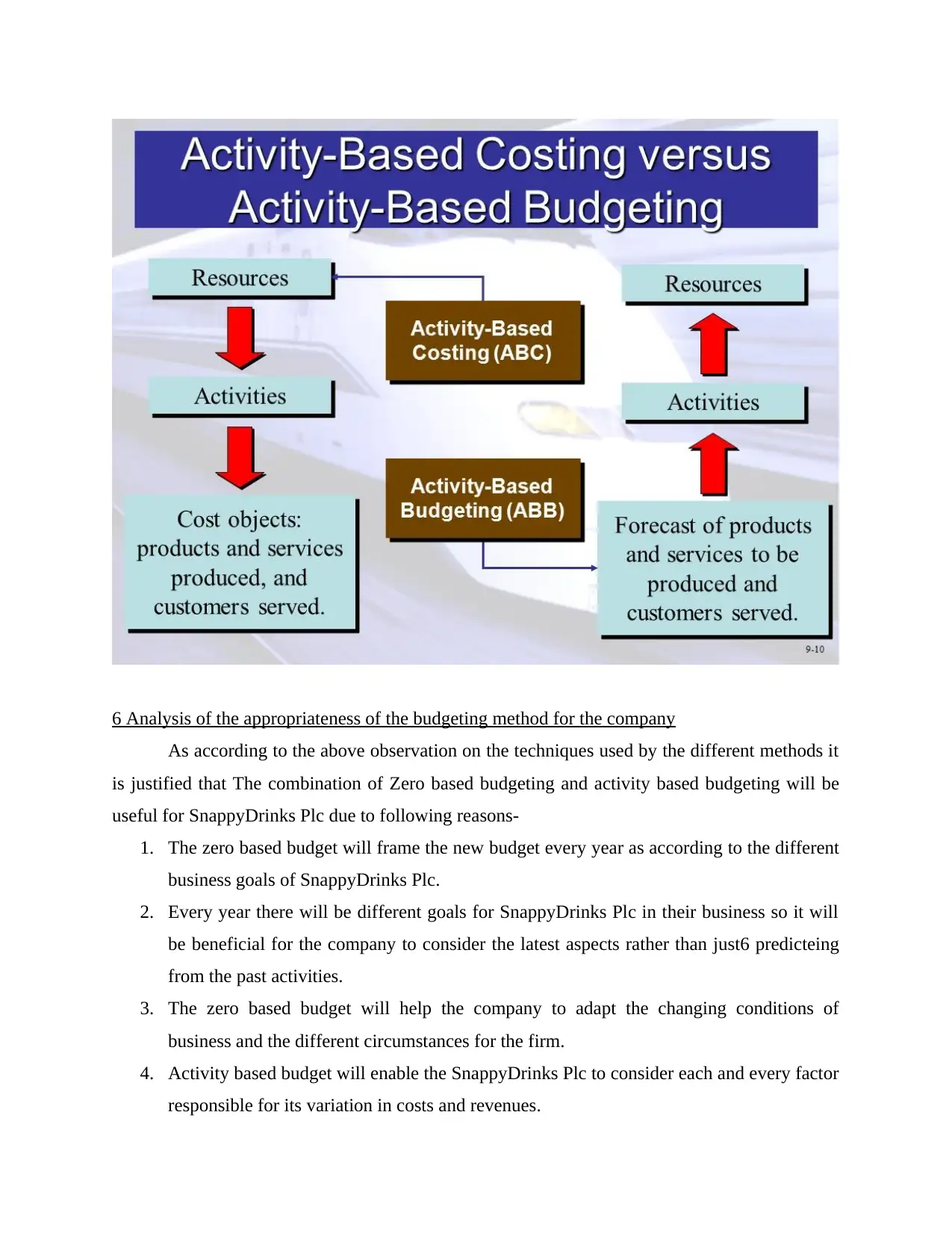
6 Analysis of the appropriateness of the budgeting method for the company
As according to the above observation on the techniques used by the different methods it
is justified that The combination of Zero based budgeting and activity based budgeting will be
useful for SnappyDrinks Plc due to following reasons-
1. The zero based budget will frame the new budget every year as according to the different
business goals of SnappyDrinks Plc.
2. Every year there will be different goals for SnappyDrinks Plc in their business so it will
be beneficial for the company to consider the latest aspects rather than just6 predicteing
from the past activities.
3. The zero based budget will help the company to adapt the changing conditions of
business and the different circumstances for the firm.
4. Activity based budget will enable the SnappyDrinks Plc to consider each and every factor
responsible for its variation in costs and revenues.
As according to the above observation on the techniques used by the different methods it
is justified that The combination of Zero based budgeting and activity based budgeting will be
useful for SnappyDrinks Plc due to following reasons-
1. The zero based budget will frame the new budget every year as according to the different
business goals of SnappyDrinks Plc.
2. Every year there will be different goals for SnappyDrinks Plc in their business so it will
be beneficial for the company to consider the latest aspects rather than just6 predicteing
from the past activities.
3. The zero based budget will help the company to adapt the changing conditions of
business and the different circumstances for the firm.
4. Activity based budget will enable the SnappyDrinks Plc to consider each and every factor
responsible for its variation in costs and revenues.
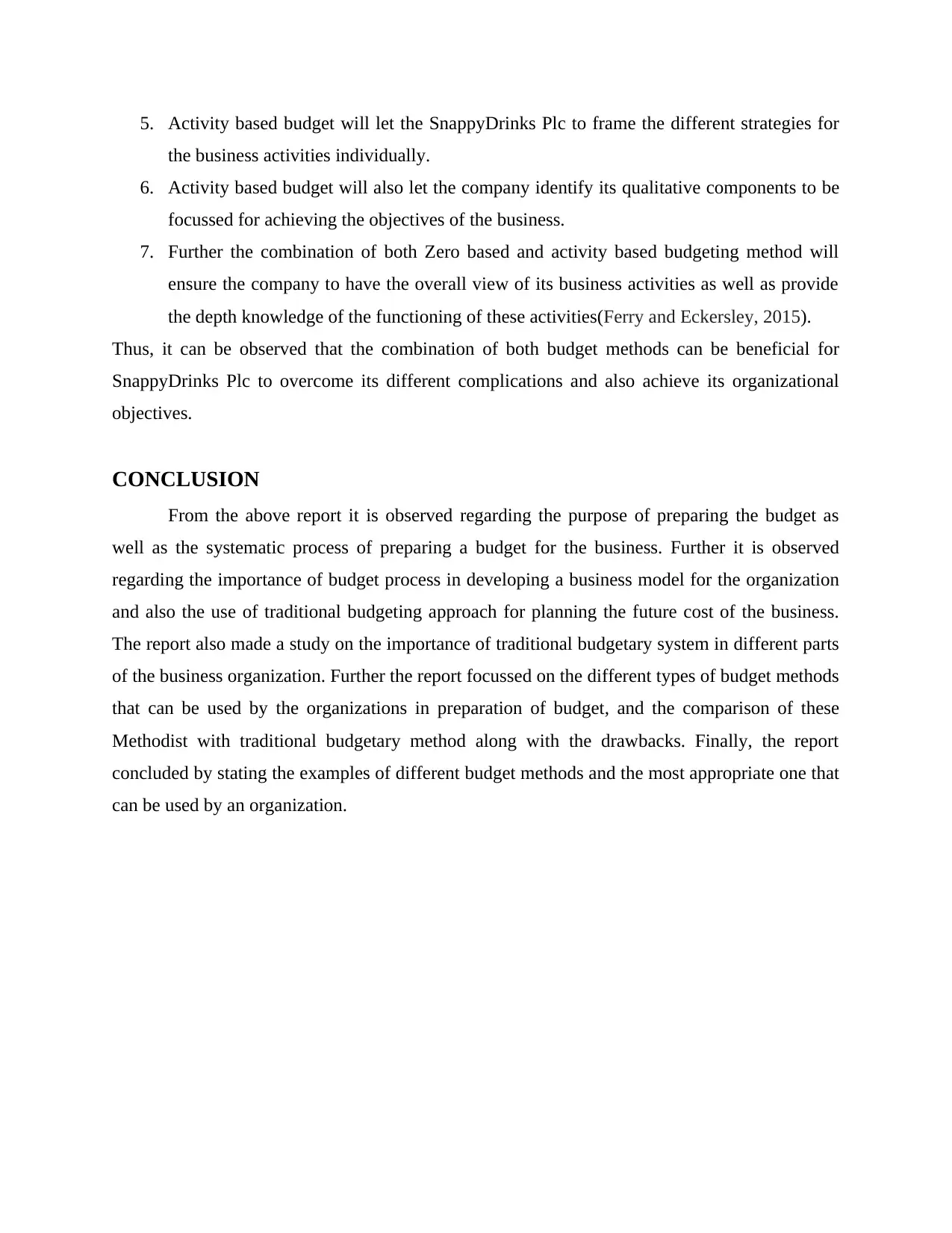
5. Activity based budget will let the SnappyDrinks Plc to frame the different strategies for
the business activities individually.
6. Activity based budget will also let the company identify its qualitative components to be
focussed for achieving the objectives of the business.
7. Further the combination of both Zero based and activity based budgeting method will
ensure the company to have the overall view of its business activities as well as provide
the depth knowledge of the functioning of these activities(Ferry and Eckersley, 2015).
Thus, it can be observed that the combination of both budget methods can be beneficial for
SnappyDrinks Plc to overcome its different complications and also achieve its organizational
objectives.
CONCLUSION
From the above report it is observed regarding the purpose of preparing the budget as
well as the systematic process of preparing a budget for the business. Further it is observed
regarding the importance of budget process in developing a business model for the organization
and also the use of traditional budgeting approach for planning the future cost of the business.
The report also made a study on the importance of traditional budgetary system in different parts
of the business organization. Further the report focussed on the different types of budget methods
that can be used by the organizations in preparation of budget, and the comparison of these
Methodist with traditional budgetary method along with the drawbacks. Finally, the report
concluded by stating the examples of different budget methods and the most appropriate one that
can be used by an organization.
the business activities individually.
6. Activity based budget will also let the company identify its qualitative components to be
focussed for achieving the objectives of the business.
7. Further the combination of both Zero based and activity based budgeting method will
ensure the company to have the overall view of its business activities as well as provide
the depth knowledge of the functioning of these activities(Ferry and Eckersley, 2015).
Thus, it can be observed that the combination of both budget methods can be beneficial for
SnappyDrinks Plc to overcome its different complications and also achieve its organizational
objectives.
CONCLUSION
From the above report it is observed regarding the purpose of preparing the budget as
well as the systematic process of preparing a budget for the business. Further it is observed
regarding the importance of budget process in developing a business model for the organization
and also the use of traditional budgeting approach for planning the future cost of the business.
The report also made a study on the importance of traditional budgetary system in different parts
of the business organization. Further the report focussed on the different types of budget methods
that can be used by the organizations in preparation of budget, and the comparison of these
Methodist with traditional budgetary method along with the drawbacks. Finally, the report
concluded by stating the examples of different budget methods and the most appropriate one that
can be used by an organization.
⊘ This is a preview!⊘
Do you want full access?
Subscribe today to unlock all pages.

Trusted by 1+ million students worldwide
1 out of 15
Related Documents
Your All-in-One AI-Powered Toolkit for Academic Success.
+13062052269
info@desklib.com
Available 24*7 on WhatsApp / Email
![[object Object]](/_next/static/media/star-bottom.7253800d.svg)
Unlock your academic potential
Copyright © 2020–2025 A2Z Services. All Rights Reserved. Developed and managed by ZUCOL.





